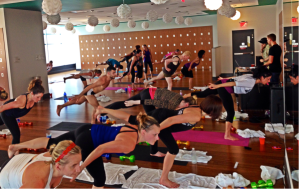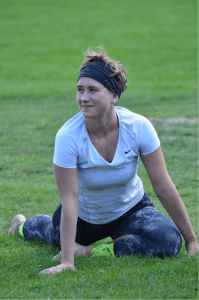5 Yoga Advantages for Runners:
- 100% engaged core
- Lengthening and strengthening major muscles
- Feet strengthening
- Upper body strength without adding muscle bulk
- Balance, agility and confidence
My first trail race was Pick Your Poison in late March 2014. At that point, I had been trail running for under a year, and frankly I barely ran over that winter period. I signed up for 25km last minute and to mine, and I’m pretty sure everyone else’s, surprise I didn’t do so badly. Post race, I wasn’t broken and I loved it so much that I immediately signed up for another race the following weekend, which also went quite well.
As I’ve been diligently running this winter, my mind still goes back to last year, pondering how the hell I ran that race and how my body recovered so quickly without much actual run training. Although my overall healthy and active lifestyle played a role, I feel that yoga, and in particular vinyasa power yoga, gave me a trail running advantage.
Listed above are 5 advantages that I review in more detail below. These advantages come with time and regular practice. I’ve been going steady (at least 1.5 hours per week) to power yoga classes for over 6 years and it’s as near and dear to me as trail running. It offers constant challenges and similar feeling of achievement and that’s why I love it so much.
- 100% Engaged Core: yoga teaches you to activate and engage your core to support your back muscles. As a result, you learn to constantly engage your core in every day life, including while sitting at your desk. This automatic engagement of core while running up and downhill certainly helps me in races.
- Lengthening and Strengthening Major Muscle Groups: especially key for leg muscles during longer distances. Holding various yoga positions for extended periods of time until you feel the burn builds and strengthens numerous muscles. This conditioned my legs for longer races, and I truly believe that it helped with the recovery as well.
- Feet Strengthening: runners know this is key to avoid injury but most don’t nearly do enough exercises. Naturally, while going through a yoga sequence on bare feet where you need to balance, place feet differently and hold positions, you strengthen your feet without even realizing you’re doing the much-needed exercises. However, you feel the workout the feet get the day after!
- Upper Body Strength Without Adding Bulky Muscles: Personally I’m not sure why most runners I know avoid building up shoulders and back muscles, because that’s what keeps me going on those strenuous and long uphills, and long runs. Doing enough downward dogs, chaturangas, and upward dogs or cobras in a sequence builds serious lean muscles in your chest, shoulders and back, helping with maintaining proper posture and overall conditioning for running.
- Balance, Agility and Confidence: Running on unexplored technical terrain can be quite intimidating even for those regularly training on trails. I feel that yoga is the perfect partner to running that provides the additional conditioning, strength and flexibility that running alone doesn’t. Practicing it gives comfort when jumping from rock to rock while running downhill as a result of balancing techniques. Knowing how to relax your upper body while always maintaining the right posture running down or uphill without shrugging your shoulders is also something you learn by combining yoga with running. There are so many more I can think of, and I’m still constantly figuring out, but these 4 are a great start as a confidence boost for a trail runner.
I hope this will encourage those runners who never tried yoga to incorporate it in your regular routine. For those who already practice it, please share how it helps you with your running. And, maybe try a more challenging pose next time or a different type of yoga.
Baddha konasana pose that stretches inner thighs, groins and knees. Just after finishing my second race of 2014, The North Face Endurance Challenge Series, at Bear Mountain, New York
Pigeon pose is my favourite after a long run, as it really helps with recovery, soreness and lengthening leg muscles. It opens up hip flexors and gluteus, helps to reduce tension and stress built up after a run in the hips and helps with the tightness.




Do you practice yoga entirely on your own?
I have considered quite some times already, but would like some sort of class for the basics…
I’d suggest taking a class as I feel instructors will be able to point out areas of improvement quicker than figuring it out on your own. Another benefit of a class is such that you’ll learn variations of sequences and may be able to come up with a personal sequence for your for pre- or post-race. Personally, I practice yoga alone and I take classes, often. With yoga classes, exploring different styles of yoga and different instructors would help with ensuring you practice it regularly. Personally, I enjoy vinyasa, power yoga as it’s dynamic and fun.
I started doing yoga last year and it has made such a huge difference in my weekly recovery. I HATE pigeon pose and swear quietly every time I have to do it but I know how good it is for me so I suck it up.
I disliked pigeon pose until I raced my first half (the picture above is taken right after the race) and it did wonders to the tight hip-flexors, never looked back again. What’s your favourite pose for after the run?
LOL. I like the ordering coffee pose. That’s part of the problem. I don’t stretch enough post run and then end up sore the next day.
I started about a month ago and feel like it has helped a bunch with flexibility, strengthening and even recovery from running
Glad to hear that Joey. For me, yoga is key for recovery as well.